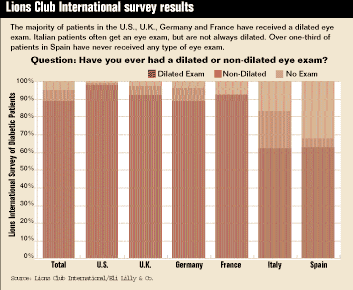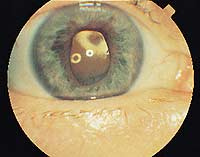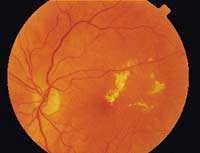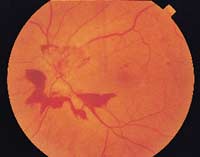Patient education, follow-up are keys for DR management
As diabetes mellitus reaches epidemic proportions in younger and younger people, so does the risk of diabetic retinopathy.
Patient education and consistent follow-up of patients with diabetes mellitus is the best way of preventing the onset or progression of diabetic retinopathy. Studies have shown that close monitoring and control of glucose levels can defer or minimize retinal damage.
|
|
Many patients, however, are not controlling their disease. An international survey conducted this year by the Lions Club International Foundation (LCIF) found that 70% of patients with diabetes could not report their last glucose level.
This statistic brings to light the importance of monitoring patients with diabetes in the ophthalmic setting in order to detect and follow ocular complications of the disease such as diabetic retinopathy (DR). Other studies suggest that some ophthalmologists may not be providing the close management that patients with diabetes require.
“There have been studies showing that patients are not getting diagnosed properly,” said Carol M. Lee, MD, a retina subspecialist in New York. “Large epidemiological studies have shown that patients who are diagnosed as requiring treatment have not received it when they look at the patients 2 and 4 years later.”
Roy D. Brod, MD, a retina subspecialist in Lancaster, Pa., agreed that most ophthalmologists know how to manage diabetic retinopathy, but said many might not realize that diabetes is now reaching unprecedented levels.
The survey by LCIF is a reminder that ophthalmic monitoring of patients with diabetes is a priority.
A press release from the organization said the survey shows that patients may not be receiving the proper information they need about their disease. Sixty percent of diabetic patients surveyed said they are not worried about going blind, and more than 40% believe they will experience complications of diabetes despite any precautions they take.
As a solution, LCIF advises stronger physician-patient communication and stresses the value of patient education in order to have the patient assist in the management of his or her disease.
What physicians should know
According to physicians interviewed by Ocular Surgery News, follow-up care and patient education are necessary in managing patients with diabetes. Patients need to know that they can help control or delay DR if they monitor their glucose levels consistently and keep their glycosylated hemoglobin levels as close to normal as possible. This may empower the patient to feel he or she has more control over the effects of the disease.
Not all patients with DR are at risk for severe visual loss, Dr. Lee said. However, she cautioned, patients with certain characteristics must be wary of complications.
In addition to the presence of neovascularization and vitreous or preretinal hemorrhage, representing proliferative retinopathy, ophthalmologists must be aware of a patient’s level of severity of internal hemorrhages, the presence of venous beading and of intraretinal microvascular abnormalities delineated in the ophthalmic literature, Dr. Lee said. Depending on the severity of these pathological signs, the ophthalmologist can determine whether the patient has an increased risk for developing proliferative retinopathy, she said.
Peter A.M. Hamilton, FRCS, FRCOphth, a retinal subspecialist at Moorfields Eye Hospital, said well-organized screening programs are important in identifying patients with diabetic retinopathy.
“Once they’ve been diagnosed, they’ll be further assessed with fluorescein angiography, color photography and clinical assessment and be given the appropriate laser treatment,” Dr. Hamilton said.
Early diagnosis is key in preventing vision loss. Assuring that patients are monitoring their glucose levels can delay the onset or reduce the severity of ophthalmic complications of the disease, he said.
Prevention, positive message
|
|
Most patients are not compliant in monitoring their glucose levels, despite evidence that such monitoring can deter diabetic retinopathy, said Robert Vigersky, MD, an endocrinologist at the Walter Reed Army Medical Center in Washington. He said ophthalmologists could play a role in changing this behavior in patients.
“Ophthalmologists are in a position to educate the patient about what retinopathy is, and if they have it, what it looks like, by showing them photographs of their own eyes and emphasizing the importance of glucose control,” Dr. Vigersky said.
Dr. Hamilton cited studies in both type 1 and type 2 diabetics “showing very much the same thing — diabetic control and control of blood pressure were important. It reduces the likelihood of retinopathy somewhere in the region of 25%. That’s really quite vital.”
Dr. Lee said she emphasizes prevention to her patients, informing them that blindness is not an inevitable result of diabetes.
“I stress to all of my patients that if we follow them at a regular interval — and we’ve determined what the interval is — that we can in many ways prevent serious visual complications from diabetes,” Dr. Lee said.
She noted that giving patients a positive outlook encourages them to return for treatment.
“Many patients with diabetes are frightened to walk into their doctors’ offices because they are afraid they are going to become blind, since that’s all they hear about. Although it’s important that they are aware that this is a potentially blinding disease, but you don’t want to scare them into not coming,” she said.
Consistent follow-up is necessary for prevention and early detection of ophthalmic complications, Dr. Brod said. How well patients control their diabetes and the level of their retinopathy determines how often a patient should be examined. Diabetics should be seen at least once a year, he said.
“It’s critical to stress to diabetic patients the importance of at least once-yearly check-ups with their eye doctor, because diabetic retinopathy can be significant, despite having excellent vision,” he said.
Individualized care is part of prevention, Dr. Brod said. For example, if a patient is known to be noncompliant with follow-up visits or treatment appointments, doing as much of the evaluation and treatment as possible in one visit should be considered in managing the disease, he suggested.
Evaluation
 In monitoring patients with diabetes, the general ophthalmologist should include certain standard components at every examination, Dr. Lee said.
In monitoring patients with diabetes, the general ophthalmologist should include certain standard components at every examination, Dr. Lee said.
“They should do a comprehensive eye examination with a slit lamp and specifically look for rubeosis or iris neovascularization, test the eye pressure, look for any pupillary abnormalities, and then do a dilated fundoscopic examination with indirect ophthalmoscopy and slit lamp biomicroscopy,” she said.
Dr. Brod said ophthalmologists should examine these patients’ retinas through the slit lamp using either a contact lens or a noncontact lens such as the 90 D or 60 D lens. The ophthalmologist should examine the macula and the retinal periphery looking for macular edema, proliferative disease, preretinal or vitreous hemorrhage and traction retinal detachment.
“The ideal method for detecting macular edema is contact lens biomicroscopy; a small macular lens placed on the cornea provides a good three-dimensional view of the macula to determine whether or not there’s thickening present. For a diabetic who might have macular edema, that’s a very important part of the exam,” Dr. Brod said.
The indirect ophthalmoscope is important when examining the periphery and through hazy media.
“If someone has a moderately dense cataract or vitreous hemorrhage, the indirect ophthalmoscope is helpful. A B-scan ultrasound is very useful in detecting traction retinal detachment when the media is opaque,” he said.
Communicate with endocrinologist
While ophthalmologists and endocrinologists may already communicate with each other regarding the management of their diabetic patients, it is important that both parties recognize the signs of retinopathy and who needs treatment, Drs. Brod and Lee said.
“What happens is that patients aren’t placed in ophthalmologic or optometric care. And sometimes ophthalmologists don’t recognize severe retinopathy and what types of patients need treatment. The statistics suggest that up to 50% don’t get the appropriate care,” Dr. Lee said.
It is important for the ophthalmologist to communicate with the endocrinologist or internist regarding the level of retinopathy, since this may give clues to the possibility of other complications of diabetes, such as kidney disease, Dr. Lee said.
“It’s very important for endocrinologists to know the level of retinopathy we are dealing with. Many studies have shown that patients with more severe eye disease will have more severe kidney disease as well,” she said.
For Your Information:Reference:
- Carol M. Lee, MD, can be reached at 161 Madison Ave., New York, NY 10016; (212) 684-2424; fax: (212) 576-2579.
- Roy D. Brod, MD, can be reached at the Lancaster General Health Campus, 2108 Harrisburg Pike, Suite 310, P.O. Box 3200, Lancaster, PA 17604-3200; (717) 399-8790; fax: (717) 399-3279.
- Peter A.M. Hamilton, FRCS, FRCOphth, can be reached at 149 Harley St., London WIN 6DE, England; (44) 207-93-54-444; fax: (44) 207-935-3061.
- Robert Vigersky, MD, can be reached at the Walter Reed Army Medical Center, Diabetes Institute, 6900 Georgia Ave. NW, Washington, DC 20307; (202) 782-5212; fax: (202) 782-0187.
- The Lions Club International Foundation can be reached at 300 W. 22nd St., Oak Brook, IL 60523-8842; (630) 571-5466
- Lions Club International Foundation. International survey reveals people with diabetes are not worried about long-term complications. June 2002



